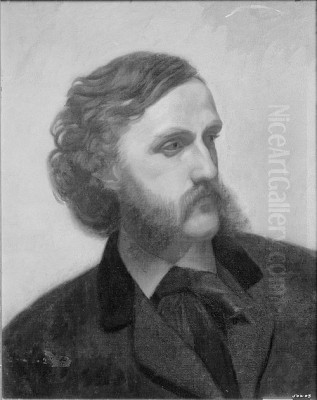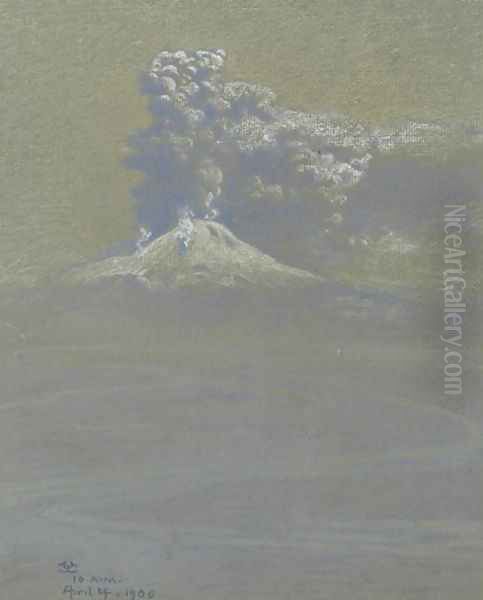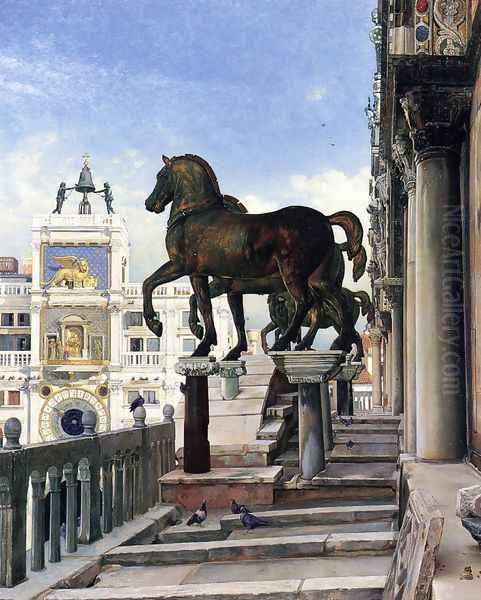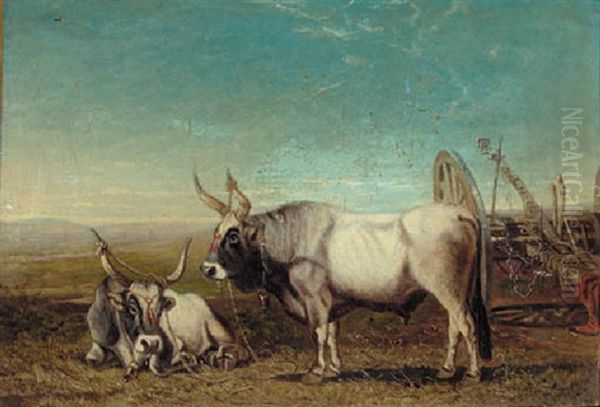
Charles Caryl Coleman stands as a fascinating figure in the landscape of late nineteenth and early twentieth-century American art. An expatriate who found his deepest inspiration under Italian skies, Coleman's work is a rich tapestry woven from American sensibilities, European academic training, and an ardent embrace of the Aesthetic Movement. His life and art offer a compelling window into a period of intense international artistic exchange and the enduring allure of Italy for creative minds.
Early Life and Artistic Awakening
Born in Buffalo, New York, on April 25, 1840, Charles Caryl Coleman's artistic inclinations emerged early. His initial training in the United States provided a foundational, if conventional, start to his journey. He studied under the tutelage of William Holbrook Beard, an artist known for his satirical paintings of animals behaving like humans, which perhaps instilled in Coleman an appreciation for narrative and character, albeit in a different vein. Another early influence was the itinerant painter Andrew Andrews, from whom Coleman likely gleaned practical skills and an understanding of the American artistic landscape of the time.
However, the artistic currents of Europe, particularly Paris, beckoned strongly to ambitious American artists of his generation. Coleman, like many of his compatriots, recognized that advanced training and exposure to the masterpieces of the Old World were essential for artistic maturation and recognition. This pull towards Europe would define the trajectory of his life and career.
The Parisian Crucible and Formative Friendships
In 1859, Coleman made the pivotal decision to travel to Paris, then the undisputed capital of the art world. There, he enrolled in the atelier of Thomas Couture, a highly respected and influential teacher. Couture, though a product of the French academic system, encouraged a more direct and painterly approach than many of his contemporaries, famously teaching artists like Édouard Manet. Under Couture, Coleman would have been immersed in rigorous training, focusing on drawing from life and studying the techniques of the Old Masters, while also being exposed to contemporary movements like Realism and the lingering spirit of Romanticism.

It was in Paris that Coleman forged one of the most significant relationships of his life: a lifelong friendship with fellow American artist Elihu Vedder. Vedder, a painter, illustrator, and poet, shared Coleman's passion for Italy and a similar inclination towards imaginative and symbolic art. Their camaraderie, born in the studios of Paris, would continue for decades, providing mutual support and artistic dialogue as they both later established themselves in Italy. This period in Paris was crucial, not only for technical development but also for shaping Coleman's artistic vision and connecting him with a network of like-minded individuals.
Italy: A Lifelong Love Affair
While Paris provided training, Italy captured Coleman's heart and soul. He first moved to Florence in 1860, a city steeped in Renaissance history and artistic treasures. The American Civil War briefly interrupted his European sojourn, compelling him to return to the United States to serve with the Union Army. However, the pull of Italy was irresistible. In 1866, accompanied by Elihu Vedder, Coleman returned to Europe, initially settling in Rome.
Rome, with its ancient ruins, vibrant street life, and thriving community of international artists, offered a stimulating environment. Coleman spent approximately a decade in the Eternal City, absorbing its atmosphere and developing his artistic voice. During this period, American artists like William Wetmore Story, a sculptor and poet, and painters such as George Inness and Albert Bierstadt (though the latter were more associated with American landscapes, their paths often crossed with expatriates in Europe) were also part of the broader international artistic community in Italy, creating a dynamic exchange of ideas.
Capri: The Villa Narcissus and an Aesthetic Paradise
Eventually, Coleman sought a more tranquil and personally inspiring setting. He found it on the enchanting island of Capri, located in the Bay of Naples. Around 1880, he acquired a former convent, which he meticulously transformed into his home and studio, naming it the Villa Narcissus. This villa became more than just a residence; it was an extension of his artistic persona, a carefully curated environment filled with antiques, objets d'art, lush gardens, and stunning views of the Mediterranean.
The Villa Narcissus was, in essence, a living embodiment of the Aesthetic Movement's ideals, emphasizing beauty, harmony, and the integration of art into daily life. Coleman lived and worked in this idyllic setting for the remainder of his life, surrounded by the beauty that so profoundly informed his art. His friend Elihu Vedder also spent considerable time in Capri, and their continued association provided a rich intellectual and artistic companionship. Coleman passed away in his beloved Villa Narcissus on December 5, 1928, at the age of 88, having spent the majority of his productive artistic life in his adopted Italian homeland.
Artistic Style: A Fusion of Influences

Charles Caryl Coleman's artistic style is characterized by its eclecticism and its embrace of beauty in its myriad forms. He was not strictly an adherent to any single school but rather synthesized various influences into a distinctive personal expression. A significant undercurrent in his work is the Aesthetic Movement, which flourished in the latter half of the 19th century. This movement prioritized "art for art's sake," emphasizing sensuous qualities, decorative effects, and the creation of harmonious compositions over overt narrative or moralizing content.
Coleman's paintings often feature a meticulous attention to detail, a rich color palette, and a palpable sense of atmosphere. His early training in Realism is evident in the careful rendering of forms and textures, but this is often overlaid with a romantic sensibility and a decorative flair. He was particularly drawn to the interplay of light and shadow, a quality he masterfully captured in his Italian landscapes and interior scenes.
A key element of Coleman's aesthetic was his fascination with Oriental art, particularly Japanese prints and decorative objects, a passion shared by many artists of the Aesthetic Movement, including James McNeill Whistler. This influence can be seen in his compositions, his use of flattened perspectives at times, and his incorporation of Eastern artifacts like ceramics and textiles into his still lifes and genre scenes. He skillfully blended these exotic elements with motifs drawn from classical antiquity and the Italian Renaissance, creating a unique visual language. His work often evokes a sense of timelessness and a deep appreciation for the cultural heritage of Italy.
Key Themes and Subjects: Italy's Enduring Charm
Italy, in all its multifaceted glory, was Coleman's principal muse. His oeuvre is dominated by depictions of Italian landscapes, architectural studies, still lifes featuring local flora and artifacts, and genre scenes that capture the spirit of Italian life.
The dramatic landscapes of southern Italy held a particular fascination for him. He painted numerous views of Mount Vesuvius, capturing its imposing presence and the atmospheric effects of its volcanic activity. These were not merely topographical records but evocative portrayals of nature's sublime power, often imbued with a romantic sensibility. The Bay of Naples, with its sparkling waters and picturesque coastline, also frequently appeared in his work.
Coleman was a keen observer of architectural details. He painted studies of ancient Roman ruins, medieval churches, and Renaissance villas, paying close attention to the textures of weathered stone, the play of light on ornate carvings, and the historical resonance of these structures. His painting The Bronze Horses of San Marco, for instance, showcases his ability to capture the grandeur and historical weight of iconic monuments.

His still lifes are exquisite examples of the Aesthetic Movement's principles. Coleman would arrange flowers, fruits, antique ceramics, glassware, and rich textiles into harmonious compositions, celebrating their inherent beauty, color, and texture. These works often possess a quiet intimacy and reveal his deep appreciation for beautiful objects and the art of arrangement. Works like Apple Blossoms are prime examples, where the delicate beauty of the flowers is juxtaposed with carefully chosen decorative items, creating a feast for the eyes.
Notable Works: A Legacy in Paint
Several works stand out as representative of Charles Caryl Coleman's artistic achievements and stylistic concerns.
_The Eruption of Vesuvius_ (various versions, including _View of Vesuvius, Effect at 11:25 am, December 21, 1913_): These paintings capture the dramatic spectacle of volcanic eruptions, showcasing Coleman's skill in rendering atmospheric effects, smoke, and incandescent lava. They are powerful testaments to his direct observation of the Neapolitan landscape and its dynamic natural phenomena. One notable depiction was his observation of the aftermath of the 1906 eruption, titled A Shower of Ashes Upon Ottaviano.
_Apple Blossoms_ (circa 1878-79): This exquisite still life is a quintessential example of Coleman's engagement with the Aesthetic Movement. It features delicate apple blossoms arranged in an Italian Renaissance-style ceramic vase, set against a backdrop of Near Eastern textiles and alongside other carefully chosen objects. The painting is a symphony of textures, colors, and cultural references, celebrating beauty for its own sake.
_The Bronze Horses of San Marco_ (circa 1876): Housed in the Whitney Museum of American Art, this painting depicts the famous Roman bronze statues that adorn St. Mark's Basilica in Venice. Coleman captures the majestic quality of the horses and the rich architectural setting, demonstrating his skill in architectural rendering and his appreciation for historical subjects.
_Still Life with Peaches and Grapes_: Typical of his lush still lifes, this work would showcase Coleman's ability to render fruit with a sensuous realism, paying close attention to color, texture, and the play of light. Such works often included elements like antique vases or rich drapery, enhancing their decorative appeal.
Capri Landscapes and Villa Scenes: Throughout his long residency in Capri, Coleman produced numerous paintings depicting the island's stunning scenery, its charming villas, and the lush gardens of his own Villa Narcissus. These works convey his deep affection for his adopted home and his ability to capture its unique light and atmosphere.
These, among many other works, demonstrate Coleman's versatility as an artist, his technical proficiency, and his unique ability to fuse diverse artistic influences into a coherent and appealing vision.
A Network of Artists: Contemporaries and Connections

Charles Caryl Coleman did not operate in an artistic vacuum. His career was interwoven with a rich network of teachers, friends, and contemporaries who shaped and were shaped by the artistic currents of the time.
His teachers, William H. Beard and Andrew Andrews in America, and notably Thomas Couture in Paris, provided him with distinct foundational and advanced training. Couture's studio was a hub, and his influence extended to artists like Édouard Manet, Puvis de Chavannes, and Americans like William Morris Hunt, with whom Coleman returned to Europe in 1866.
The most profound artistic friendship was with Elihu Vedder. Their shared experiences in Paris and later in Italy, particularly Rome and Capri, fostered a lifelong bond. Vedder's own work, often mystical and symbolic, resonated with Coleman's aesthetic sensibilities, though their styles remained distinct.
As an expatriate in Italy, Coleman was part of a vibrant international community. While perhaps not always direct collaborators, he would have been aware of and likely interacted with other prominent American artists working in Italy, such as the sculptor William Wetmore Story or painters like John Singer Sargent (though Sargent was of a slightly younger generation, their paths in the expatriate world could have crossed) and Frank Duveneck. The influence of the "Duveneck Boys," American artists who studied with Duveneck in Munich and Italy, also contributed to the American artistic presence abroad.
Coleman's embrace of the Aesthetic Movement connected him ideologically with artists like James McNeill Whistler, whose "art for art's sake" philosophy and incorporation of Japanese aesthetics paralleled Coleman's own interests. In England, figures like Dante Gabriel Rossetti, Edward Burne-Jones, Albert Moore, and Frederic Leighton were central to the Aesthetic Movement, and their work would have been known to Coleman through publications and exhibitions, contributing to the transatlantic dialogue on aestheticism.
The broader context of 19th-century art also includes the Barbizon School painters like Jean-Baptiste-Camille Corot and Jean-François Millet, whose emphasis on naturalism and plein air painting influenced Couture and, by extension, his students. Even earlier American landscape traditions, such as the Hudson River School with artists like Thomas Cole and Asher B. Durand, formed the backdrop from which artists like Coleman sought further European refinement.
Exhibitions, Recognition, and Memberships
Throughout his career, Charles Caryl Coleman actively exhibited his work on both sides of the Atlantic, gaining recognition for his distinctive style. He was a regular contributor to major American exhibitions, including those at the National Academy of Design in New York, where he was elected an Associate Member (ANA), and the Pennsylvania Academy of the Fine Arts in Philadelphia, which later made him an honorary member.
His work was also shown in Europe, likely at the Paris Salon and various exhibitions in London and Rome, reflecting his status as an established international artist. His Villa Narcissus in Capri became a destination in itself, a showcase of his taste and a place where patrons and fellow artists could view his work in an ideal setting.
Coleman was affiliated with several prestigious art organizations, including the Players Club and the National Arts Club in New York. These memberships indicate his standing within the artistic and cultural circles of his time.
Even after his death, his work continued to be recognized. In December 1928, shortly after his passing, the Brooklyn Museum (then the Brooklyn Institute of Arts and Sciences) organized a memorial exhibition of his oils, watercolors, and pastels, a testament to his contributions and the esteem in which he was held. More recently, his works have been included in thematic exhibitions exploring 19th-century American art and the Aesthetic Movement, such as "Objects of Desire: 19th-Century American Still Life Painting."
Legacy and Enduring Presence
Charles Caryl Coleman's legacy is that of a dedicated and skilled artist who successfully navigated the transatlantic art world of his era. He carved out a unique niche for himself, creating a body of work that celebrated beauty, craftsmanship, and the rich cultural heritage of his adopted Italy. His deep immersion in Italian life and landscape, combined with his sophisticated understanding of prevailing artistic trends like the Aesthetic Movement, resulted in paintings that continue to charm and engage viewers.
His Villa Narcissus in Capri stands as a symbol of his artistic vision, a place where art and life were seamlessly intertwined. While perhaps not as widely known today as some of his more revolutionary contemporaries, Coleman's work holds an important place in the story of American expatriate artists and the development of the Aesthetic Movement in America.
His paintings are held in the collections of numerous important American museums, including the Brooklyn Museum, the Whitney Museum of American Art, the Detroit Institute of Arts, the Museum of Fine Arts, Boston, and the Metropolitan Museum of Art, New York. These holdings ensure that his artistic contributions remain accessible for study and appreciation by future generations.
Conclusion: An Artist Between Worlds
Charles Caryl Coleman was an artist who truly found his voice in a foreign land. His journey from Buffalo, New York, to the sun-drenched island of Capri is a story of artistic pilgrimage and profound personal connection to place. He masterfully blended his American roots with European training and a deep affinity for Italian culture, light, and landscape. As a key figure among American expatriate painters and a notable proponent of the Aesthetic Movement, Coleman created a legacy of beautiful, evocative works that capture the essence of Italy as seen through the eyes of a devoted and sensitive observer. His art remains a testament to the enduring power of beauty and the rich dialogue between cultures that characterized his era.